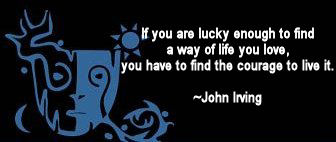|
Contemporary Fantasy's Foliate Face:
An Interview with Charles Vess
by Kelly Searsmith
First published in the ICFA Journal, and used by permission
 The twenty-seventh annual International Conference for the Fantastic in the Arts, held in Ft. Lauderdale in March 2006, was fortunate to have as its Guest of Honor Charles Vess, an American storyteller best known for his artistic work in support of mythic narratives. Now at the height of his artistic career, Vess has collaborated with some of the most gifted fantasy writers of his generation, and already won the most prestigious awards in the fantasy and comic-book arts, including the 1999 World Fantasy Award and the Will Eisner Comics Industry Award (twice). In June, Charles and I continued the conversation about his work and the fantasy arts that began at ICFA-27. The twenty-seventh annual International Conference for the Fantastic in the Arts, held in Ft. Lauderdale in March 2006, was fortunate to have as its Guest of Honor Charles Vess, an American storyteller best known for his artistic work in support of mythic narratives. Now at the height of his artistic career, Vess has collaborated with some of the most gifted fantasy writers of his generation, and already won the most prestigious awards in the fantasy and comic-book arts, including the 1999 World Fantasy Award and the Will Eisner Comics Industry Award (twice). In June, Charles and I continued the conversation about his work and the fantasy arts that began at ICFA-27.
How would you describe the different phases of your career?
I started freelancing as an illustrator in 1974, right after I had completed my degree program (BFA) at Virginia Commonwealth University. And for at least ten years or so, I said yes to any freelance illustration assignment that anyone offered me. There wasn't much philosophical thought in accepting any of those jobs other than the desire to eat and pay the rent. I'd always known the work that I'm doing now is what I really wanted to do, but I also knew there was a matter of having to pay my dues as an artist. First I would need to establish myself and then start going after the things that I really would like to do. In 1976 I moved to New York City so I would have a lot more publishing opportunities than the local Richmond, Virginia scene was offering. Once in Manhattan I would go out and pound the pavement with my portfolio for days on end.
Somewhere in the early 1980s I remember that instead of constantly having to shove my portfolio under art director's noses that I began to get calls from publishers asking me to do work for them. That was an exciting time for me. I also remember a point soon after when I could begin to say 'no' to any job that had space ships or technology in it because I just have a really hard time drawing that type of subject matter. This technical imagery didn't make my mind sing with joy and energy. And I know that the more personal enjoyment I have in a piece, the better the artwork's going to be and the more emotional impact it will have for the people looking at it.
And you've said you don't like drawing buildings, either.
Well, more specifically, I don't care for contemporary architecture. I can draw all those things, but it's not something that just naturally falls out of my pencil.
Around the mid-80s I was starting to do graphic novels for Marvel comics. I did one called The Raven Banner that's based on an actual Nordic myth. It goes that a chosen family will hold this particular banner and have the 'honor' to carry it into battle bringing victory to his companions. However the downside is that that individual will die gloriously in battle and then be lifted up by the Valkyries to live in Odin's golden meade hall in Valhalla endlessly doing battle during the day and drinking the All Father's meade at night. Some fun, you bet. So, (Raven Banner) was a riff off of that actual Nordic Legend, only our hero had no particularly wish to die in battle. The book's central characters were created by writer Alan Zelentz and myself with the use of several secondary Marvel characters from their quasi-Nordic mythology such as Thor, The Warriors Three, etc. which is why it was published under the Marvel imprint. that's based on an actual Nordic myth. It goes that a chosen family will hold this particular banner and have the 'honor' to carry it into battle bringing victory to his companions. However the downside is that that individual will die gloriously in battle and then be lifted up by the Valkyries to live in Odin's golden meade hall in Valhalla endlessly doing battle during the day and drinking the All Father's meade at night. Some fun, you bet. So, (Raven Banner) was a riff off of that actual Nordic Legend, only our hero had no particularly wish to die in battle. The book's central characters were created by writer Alan Zelentz and myself with the use of several secondary Marvel characters from their quasi-Nordic mythology such as Thor, The Warriors Three, etc. which is why it was published under the Marvel imprint.
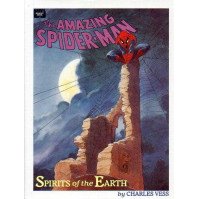 Then a bit later I worked with their Spider-man character. I wrote, drew and painted a Spider-man graphic novel — called Spirits of the Earth Then a bit later I worked with their Spider-man character. I wrote, drew and painted a Spider-man graphic novel — called Spirits of the Earth . In my story I sent him to Scotland because I thought that would be fun; I love Scotland. I thought having him, a city-bred person, in a completely rural landscape where he would have to deal with things in a different way would be interesting. He couldn't just flip that web and swing away from whatever bad guy he was having to deal with. The nearby castle would be as tall a building as you're going to get out there in the highlands. . In my story I sent him to Scotland because I thought that would be fun; I love Scotland. I thought having him, a city-bred person, in a completely rural landscape where he would have to deal with things in a different way would be interesting. He couldn't just flip that web and swing away from whatever bad guy he was having to deal with. The nearby castle would be as tall a building as you're going to get out there in the highlands.
What did you like about the Spider-man character?
For one thing, when I was much, much younger, I was a huge Spider-man fan. I used to do gymnastics in high school (I'm far too short to shoot basketball) thinking about being him.
For another, he was an individual; it wasn't a giant team of various super beings such as the X-Men or The Fantastic Four. I had been working as an illustrator/comic book artist for almost ten years by then. Except for a small group of ardent fans, no one really knew who I was. Something that I had come to realize, especially in the comic/graphic novel field, is that the retailers that run the typical comic book shops are the gatekeepers to what is and isn't on their shelves. If they aren't aware of your work, then there is little chance that it will be displayed for sale. And working with such a prominent character certainly served to raise my recognition factor among those particular gatekeepers. So there was partly that commercial justification for why I produced the book, but I really couldn't have spent all the time that I lavished on Spirits of the Earth without my early love of the Spider-man character, as well as my infatuation with the Scottish highlands. Somehow, I managed to combine a commercial product with a story that I really loved.
Is Spider-man's less violent approach to bringing down bad guys part of the webslinger's appeal for you?
The thing that I don't like about super heroes is that in the end the decision as to whether the forces of evil or of good will win is made by who has the bigger fist. It's not a philosophy that I have in life nor one that I wish to support in the work that I do for publication. So, at the conclusion of that graphic novel there is the typical fist fight. I really had to juice my brain up to draw it. It wasn't something I particularly wanted to do. I'm much more interested in subtlety and the connection between humans and the landscape, how the landscape affects the people and the plot of a particular narrative.
Where did your career go next?
By almost pure coincidence, Issue 19 of The Sandman (the story that features Neil (Gaiman)'s riff on Shakespeare's A Midsummer Night's Dream that I illustrated) came out within a month of Spirits of the Earth. Having both of those high profile projects come out so close to each other finally gave me that retail recognition I'd been lacking. My art was suddenly connected to two particular characters that were very popular. It was then that, especially after working with Neil Gaiman and several other high calibre writers, I realized that if you as an artist are working with really good writing, your art becomes better. You have to reach down and dig a lot out of your unconscious in an effort to keep up with the writing, and my work took a certain leap in quality. (the story that features Neil (Gaiman)'s riff on Shakespeare's A Midsummer Night's Dream that I illustrated) came out within a month of Spirits of the Earth. Having both of those high profile projects come out so close to each other finally gave me that retail recognition I'd been lacking. My art was suddenly connected to two particular characters that were very popular. It was then that, especially after working with Neil Gaiman and several other high calibre writers, I realized that if you as an artist are working with really good writing, your art becomes better. You have to reach down and dig a lot out of your unconscious in an effort to keep up with the writing, and my work took a certain leap in quality.
I realized I needed to start initiating my own projects coupled with that level of writer, as opposed to waiting for publishers to approach me. So that's what I'm doing now.
When did you start Green Man Press?
Green Man Press was started in 1994 as a place for me to publish my art prints and other publishing projects. I had a number of friends who were exploring the benefits to self-publishing their own comics. I should explain that the best thing about comics is that one person can control the vision of the finished product; it's much like writing a book. When the book comes out, it's that author's voice that you're reading. In a comic, at least in one that's written and drawn by one person, what is published is a very personal viewpoint.
So I came up with this crazy, seemingly non-commercial idea for a comic book. For years I'd been listening to Scottish and English folk and folk-rock music, from Joan Baez to Steeleye Span. It occurred to me that all those wonderful songs had stories that would be really fun to draw. I approached a number of writers that I admired, and asked them to be involved in this project, and got a 'yes' from just about every one.
Even with the sort of commercial caché that I had at that point, if I had approached any publisher with the idea of publishing my comic book series, The Book of Ballads and Sagas , they would have looked at me in horror and run the other away. It's not what anyone would think of as a commercial idea. But it sold quite well; it was interesting to do. , they would have looked at me in horror and run the other away. It's not what anyone would think of as a commercial idea. But it sold quite well; it was interesting to do.
The Book of Ballads and Sagas had quite a crossover, too, generating great interest from musicians, folklorists, SF/fantasy fans, comic book lovers, librarians, historians, etc. I was contacted by the managing editor of Sing Out, which is a very long-running magazine on folk music. He was also a comic book fan — very excited that I was doing this project, and eventually ran four or five stories over a two year period in his very trad-music magazine. So I ended up with a lot of subscribers who came to my series from that magazine who had never read a comic in their lives, folk music affectionados and such.
Ever since then I've been using the Green Man Press imprint for whatever I would like to publish that's totally my own idea.
Earlier in your career you illustrated graphic novels. More recently, you've concentrated on illustrating books. As an artist, is there a difference in the attitude you take toward a medium of storytelling that's primarily visual compared to one in which illustration only supports the text?
Yes, of course there is. Right now I'm illustrating a collection of short stories by Susanna Clark: The Ladies of Grace Adieu and Other Stories , with eight short stories in it. She has a way of relating the specific events in her stories that — without her actually describing the exact details of that event — lets you, as a reader, know that certain actions have occurred, off camera as it were. This manner of description makes you, as a reader, become more personally involved in her telling of the tale. I really hadn't gotten that kind of frisson out of reading what is in fact only implied by the text but still creates such vivid imagery in my mind since reading The Bloody Chamber , with eight short stories in it. She has a way of relating the specific events in her stories that — without her actually describing the exact details of that event — lets you, as a reader, know that certain actions have occurred, off camera as it were. This manner of description makes you, as a reader, become more personally involved in her telling of the tale. I really hadn't gotten that kind of frisson out of reading what is in fact only implied by the text but still creates such vivid imagery in my mind since reading The Bloody Chamber by Angela Carter. I knew that I needed to be very, very careful about what I chose to illustrate. There were some scenes that I would have really, really loved to have drawn but I knew that they, in fact, shouldn't be drawn, because each reader needed to be allowed to participate in their own visual reading of the story. by Angela Carter. I knew that I needed to be very, very careful about what I chose to illustrate. There were some scenes that I would have really, really loved to have drawn but I knew that they, in fact, shouldn't be drawn, because each reader needed to be allowed to participate in their own visual reading of the story.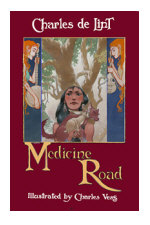 So, although I couldn't resist drawing portraits of some of the author's already established characters (especially Jonathan Strange, who shows up in a one story, and the Raven King in several others), I attempted to render them in such a way that my visualization is not so concrete as to hamper the readers previously constructed image of these iconic characters. So, although I couldn't resist drawing portraits of some of the author's already established characters (especially Jonathan Strange, who shows up in a one story, and the Raven King in several others), I attempted to render them in such a way that my visualization is not so concrete as to hamper the readers previously constructed image of these iconic characters.
I always try to think of myself as collaborating with the author of a given text when I'm illustrating, even when that author is long dead.
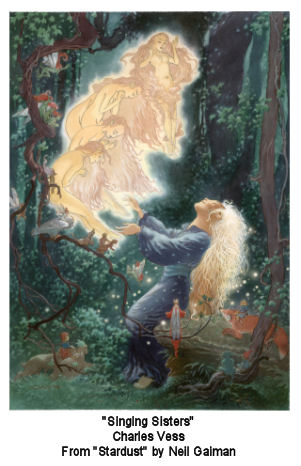
In an instance ( such as Stardust with Neil Gaiman or Medicine Road with Neil Gaiman or Medicine Road with Charles de Lint) when I'm collaborating on a book that's being newly written and I'm participating in its actual creation then I have absolutely no problem in rendering detailed portraits of any of the characters as well as any elements from the story that I want to. Because in that circumstance it would be the first time anyone is actually seeing that 'world' and, as I'm its co-creator, I would have no qualms whatsoever about making its visualization concrete to the reader/viewer. with Charles de Lint) when I'm collaborating on a book that's being newly written and I'm participating in its actual creation then I have absolutely no problem in rendering detailed portraits of any of the characters as well as any elements from the story that I want to. Because in that circumstance it would be the first time anyone is actually seeing that 'world' and, as I'm its co-creator, I would have no qualms whatsoever about making its visualization concrete to the reader/viewer.
But if you're illustrating A Midsummer Night's Dream , for instance, or any number of stories that have been around for years and years and years, you have to approach the drawing in a different manner and try to respect the power of the storytelling as well as the participation of the reader/viewer. , for instance, or any number of stories that have been around for years and years and years, you have to approach the drawing in a different manner and try to respect the power of the storytelling as well as the participation of the reader/viewer.
What do you think of Peter Jackson's take on The Lord of the Rings, then? He certainly had every opportunity to disappoint viewers who had imagined the books differently.
Since I read Lord of the Rings for the first time in the early 1960s, I have, over the intervening years, developed my own visuals. So when I watched those movies, I would accept some of what he gave me and reject imagery. His adaptation was really powerfully told, I loved it, especially the extended DVDs, where he put all the quiet scenes back in. Still, I have that ability to go, 'That's not what an ent looks like' or 'That's not my Balrog.' But I do wonder sometimes about the people who are watching those movies but have never read the books. Suddenly, for them, that's what an elf looks like or that's what an orc looks like. Jackson's very powerful visual iconography might tend to freeze the newcomer to that wonderful story imagination. And, certainly, if those movies are their one and only experience of that story, then they will always be missing the 'scouring of the Shire' and the layers of meaning that that particular passage gives Tolkein's epic tale. But still, there will be hundreds of illustrators that can and should give the reader very different visual interpretations of that same text. One of the presenters at ICFA this year — she's from Finland — sent me a copy of The Hobbit illustrated by Tove Jansson, who did the Moominland series. Jansson produced a series of thirty or forty very simple black-and-white drawings for the book that are really quite splendid. They're really fun to look at; so very anti-Alan Lee (whose work I adore by the way). series. Jansson produced a series of thirty or forty very simple black-and-white drawings for the book that are really quite splendid. They're really fun to look at; so very anti-Alan Lee (whose work I adore by the way).
At ICFA-27, you talked about how 'visionary' artists have inspired you through their unconscious, or archetypal, visual references. How do you define visionary art, and who are some of the major figures in it that have affected you?
It's unfortunately a totally arbitrary name for that group of artists. 'Visionary' is used to describe so many different groups of artists. The most prevalant are the modern visionaries whose art is dark, morbid and full of existential unease; they're very popular in Europe where there are many, many artists working in that style. H.R. Giger would be a prime example of that school of art. It's not something that I respond to very well. It's not that I want everything happy and whimsical; I do like an edge to things. But, I'm not a pessimistic person, so I don't see life as all pain, and that's the only way you know you're alive.
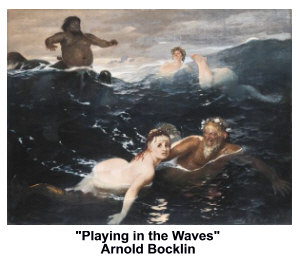 There are several other schools of contemporary 'visionary' artists, including the American outsider artists (think Howard Finster) so that that designation's boundaries become very blurry. So my 'visionary artists' start with Arnold Böcklin, a Swiss artist from the mid-1800s. His most famous painting is Isle of the Dead, but he also filled canvas after canvas with mythological creatures; fauns, mer-creatures, nymphs, dryads and satyrs all dance through landscapes saturated with a deep Mediterranean sunlight. They're really fun to see, especially if your only experience with that mythology is Disney's Fantasia, where everything's squeaky clean, everyone's had their bath. In Böcklin's world those goat men have been living in the wild their entire lives, and they haven't had a bath in probably ever. The rain gets on them; they're very earthy. You can almost smell the musk on them. The sea people have seaweed dripping off them and around them. They're very, very earthy, and it's like, 'Well of course, that's what those creatures look like.' There are several other schools of contemporary 'visionary' artists, including the American outsider artists (think Howard Finster) so that that designation's boundaries become very blurry. So my 'visionary artists' start with Arnold Böcklin, a Swiss artist from the mid-1800s. His most famous painting is Isle of the Dead, but he also filled canvas after canvas with mythological creatures; fauns, mer-creatures, nymphs, dryads and satyrs all dance through landscapes saturated with a deep Mediterranean sunlight. They're really fun to see, especially if your only experience with that mythology is Disney's Fantasia, where everything's squeaky clean, everyone's had their bath. In Böcklin's world those goat men have been living in the wild their entire lives, and they haven't had a bath in probably ever. The rain gets on them; they're very earthy. You can almost smell the musk on them. The sea people have seaweed dripping off them and around them. They're very, very earthy, and it's like, 'Well of course, that's what those creatures look like.'
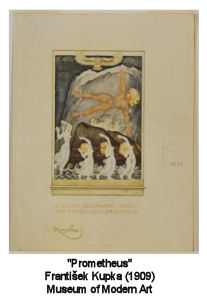 There are a number of artists from that time period whose work really inspires me. A lot of them went on to be abstractionists or expressionists. Frantisek Kupka is someone I studied in college as an expressionist, but later discovered that he did these incredible paintings earlier in his career that are mysterious, evocative and poetic — visionary in the best sense of my meaning of the word — everything that I'd want a painting to be. Their imagery evokes stories; there's lots of poetic visual space for the viewer to make up their own minds about what it is they're looking at. I'm not saying that it's abstract; I'm just saying that it's not... . There's a tendency in modern sf/fantasy art and in modern movies to show every detail; everything is lit in such a way as there are no mysterious shadows, no poetic work space for the viewer to participate in the narrative. His work is redolent with that poetry. There are a number of artists from that time period whose work really inspires me. A lot of them went on to be abstractionists or expressionists. Frantisek Kupka is someone I studied in college as an expressionist, but later discovered that he did these incredible paintings earlier in his career that are mysterious, evocative and poetic — visionary in the best sense of my meaning of the word — everything that I'd want a painting to be. Their imagery evokes stories; there's lots of poetic visual space for the viewer to make up their own minds about what it is they're looking at. I'm not saying that it's abstract; I'm just saying that it's not... . There's a tendency in modern sf/fantasy art and in modern movies to show every detail; everything is lit in such a way as there are no mysterious shadows, no poetic work space for the viewer to participate in the narrative. His work is redolent with that poetry.
All of those artists have a lot to teach modern illustrators. I really think that all art should involve the viewer's imagination. I don't think there's much room for anyone to look at most of the art you see on paperback book covers and participate in its narrative impulse, when every toenail, every glint on every piece of chain mail is painted accurately, and beautifully, and is far too well lit. I quickly get bored with that type of visual narrative.
In the nineteenth-century, before our modern visual media, book illustrations, touring painting shows, portrait galleries were so popular because people lacked, and longed to have, visual anchors for imagined and discursive experiences. Given our much more visually-anchored culture, is this desire of yours to let the viewer be more participatory a response to information overload?
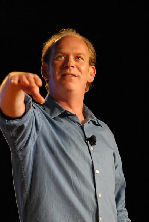 Well it is, but it's also just knowing the power of storytelling when it really works. My wife, Karen Shaffer, and I were at the latest Mythic Journeys conference, where we saw/heard a brilliant storyteller, Charlie Bethel. He told the entire story of Beowulf, just himself, on the stage for approximately an hour. He had a thousand people in the audience totally riveted. Several times during his presentation I was able to pull back and think to myself, 'This is so cool. All these people have their own visual of the story being told, and each and every one of them is totally different.' I was imagining all those diverse images interweaving in air of that huge auditorium. It's extraordinary how pure oral storytelling can activate the individual imagination . So again, it seems to me that most modern TV, movies or video games seem to give the viewer too much information and not enough stimulation for the poetic imagination. So, in a sense, my desire for an evocative visual poetry in art is a reaction to that. Well it is, but it's also just knowing the power of storytelling when it really works. My wife, Karen Shaffer, and I were at the latest Mythic Journeys conference, where we saw/heard a brilliant storyteller, Charlie Bethel. He told the entire story of Beowulf, just himself, on the stage for approximately an hour. He had a thousand people in the audience totally riveted. Several times during his presentation I was able to pull back and think to myself, 'This is so cool. All these people have their own visual of the story being told, and each and every one of them is totally different.' I was imagining all those diverse images interweaving in air of that huge auditorium. It's extraordinary how pure oral storytelling can activate the individual imagination . So again, it seems to me that most modern TV, movies or video games seem to give the viewer too much information and not enough stimulation for the poetic imagination. So, in a sense, my desire for an evocative visual poetry in art is a reaction to that.
There are certain forms of contemporary fantasy art that are more readily labeled 'fine' or 'subversive,' such as the pop surrealism promoted by Seattle Roq la Rue Gallery owner, curator Kirsten Anderson through exhibitions and her book Pop Surrealism: The Rise of Underground Art. Such work seems to have a twisted, perverse, neo-gothic, lowbrow (as in pop culture), or ironic cast, which accounts for its current 'bad boy' appeal. I'm thinking of Roq la Rue-featured artists such as Marion Peck, Camille Rose Garcia, Mark Ryden, John John Jesse, Alex Gross — and others who aren't featured there, such as Ted Biskup.
To be accepted by contemporary gallery-type people, art needs to be commenting on itself and ugly. And by ugly I mean that subject matter needs to be post-modern and ironically distant from genuine emotions as well as the paint itself. Black pigments mixed with pink is a popular chromatic scale. Ugly seems to be naturally equated with real. It's just the same as if a writer chooses to depict their characters living sordid lives full of despair as they pick their way through the gutter of their existence, shooting up with drugs, dying horribly, then that's considered real. But if you see your characters as people that possess some modicum of hope, that laugh amongst themselves and sometimes help each other through the desperate situations that life can offer, then that story would be criticized as maudlin, with no basis in reality. And, of course, reality really is a mixture of the two but the overwhelming modern critical bias is to exalt the ugly and ignore a call to beauty.
You've said that gallery sort of fantasy art shows a more pessimistic view of life. However, your own work also presents some dark (The Unquiet Grave), mysterious (Midnight Grove), and erotic (A Dream of Apples) subjects. It seems to do so in a different way, and to impact viewers differently as well. Would you elaborate on the difference in technique?
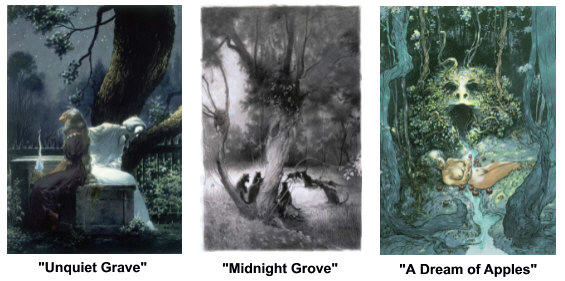
It's a matter of pacing, and of contrast. As an artist you can have a beautiful pastoral landscape, but maybe you can also put an owl in that landscape that is doing what comes naturally to it and eating a cute little chipmunk. Beauty and reality side by side but that edge of natural violence makes the beauty sharper and more meaningful.
Is there something inherently problematic with the dominant Disney style of fairy tale art? Or do you avoid the style just because it's become so cliché?
My problem with the Disneyfication of the fairy tale world is its over simplification of very complex psychological tales. They have made that world into a bright and happy place, where there's only ever one bad person, and they're really easy to figure out because they're always wearing black. Disney has also almost always made the female lead into a subservient character, waiting for her prince to ride by and make everything a-okay. It's not the native intelligence or desire to succeed that brings Cinderella to her place of safety at the conclusion of her story but all her clever little singing animal friends and her sweet fairy god-mother. And that's just not what those fairy tales were ever about. The've robbed those tales of their mythic resonance. The once-upon-a-time-when-we-all-lived-in-the-dark-of-the- woods has, in the Disney film, become a small, well lit suburban forest which has little to teach the psyche and thus little or no relevance to modern lives.
They have been trying to update that.
Yeah, they have tried, but even with a relatively contemporary effort such as their adaptation of Beauty and the Beast, it's still a problem. [Belle] does read now, but still she's being saved by the Beast and all the other characters around her rather than her own strengths.
How do you resist that commercial pull? You've talked about trying to find more surprising, fresh, authentic images. I know when you dig deep into the unconscious for a new image, it's not a very conscious process, but how do you know when you've found it?
You just know. When I see another artist's image that makes me want to run to my drawing board and create, or I see something in real life that makes me gasp, because it's made me look at a particular story in a completely new way.
Some modern authors have encouraged their publishers to let them use artists whose work goes against the sci fi/fantasy cover stereotypes.
The art director may completely agree with that desire, but it's really the marketing people that have much more of a role in determining what's on the cover than anyone wants to talk about. I've never painted in the style that is typically what marketing wants to see on a book jacket. Which is to say, an image with every nut and bolt clearly and precisely delineated, nor do I even think that way.
And yet you've found an audience for your work, and some other contemporary fantasy writers and artists have been able to develop in that same vein. How do you describe that audience? Is it different from the stereotypical sci fi/fantasy audience?
I have to say: There's absolutely nothing wrong with straight, out-and-out genre fantasy stuff; it just doesn't interest me that much as a reader or an artist. But, there are a lot of writers working today — Charles de Lint, Terri Windling, Delia Sherman, Ellen Kushner, Jeffrey Ford, Alice Hoffman, Elizabeth Hand, Ellen Klages, Neil Gaiman, to name but a few — who have developed a school of mythic fiction that particularly excites me. These writers are not using the typical epic fantasy tropes over and over again in their work but exploring a contemporary world that is suffused with both the ordinary and the magic. Their readers want to be surprised; that's the audience that I'm looking for.
I am their audience. I've read reams of fairy tales and more than my share of tales featuring dragons and giant armies of fantastic creatures or evil magicians out to rule whichever world that they live in and truly loved doing so, but now I want something more. A tale that is still suffused with magic, but magic of a wholly unexpected kind.
Why are you so drawn to Celtic and Germanic myth in particular?
I was just a presenter again this year at the Mythic Journeys conference. One of the things they asked each presentor for was that we send them two or three written or visual touchstones that were our particular touchstones or doorway into myth. I sent them a page of artwork from a Marvel comic book that featured Tales of Asgard, a long-running series from the mid-1960s about the Nordic Gods. Up until that point in my life I had only been reading Greek myths and that discovery of Norse mythology was a revelation to my adolescent mind.
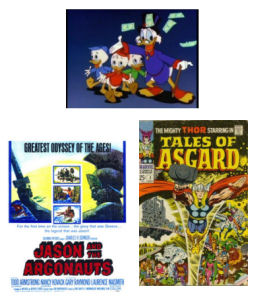 My second entry was the movie poster from a particular Ray Harryhausen fantasy adventure film that he was producing in the 50s and 60s, Jason and the Argonauts. Those films and also the myriad Italian 'sand and sandal' epics, as they were called — all with very bad dubbing as well as really badly bastardized versions of Greek mythology — were fascinating to me nonetheless. They were my original doorway into the world of myth and fairy tales. My second entry was the movie poster from a particular Ray Harryhausen fantasy adventure film that he was producing in the 50s and 60s, Jason and the Argonauts. Those films and also the myriad Italian 'sand and sandal' epics, as they were called — all with very bad dubbing as well as really badly bastardized versions of Greek mythology — were fascinating to me nonetheless. They were my original doorway into the world of myth and fairy tales.
Then there were the Uncle Scrooge comics that told grand adventure stories where Scrooge, Donald and his nephews were always discovering yet another lost civilization in one hare-brained scheme after another in an effort to make their uncle even richer. The writer and artist of these intricate tales was Carl Barks whose extensive research into geography and world history grounded these fanciful stories in enough reality for his readers to accept all of his wildest speculations.
All of these discovered mythologies caused me to question my own 'reality' and to think 'oh, that's interesting,' and then run to the library to read more. When I was growing up, I had no friends that were interested in fantasy or science fiction or mythology, so it was only by stumbling into something and taking advantage of that stumble that I discovered the world that I now feel at home in.
I became aware of Celtic art and story soon after the Tolkien books were first put out in paperback in the early 1960s. Then the Lin Carter series, the Sign of the Unicorn books, gifted me with more discoveries that were very important to my growing admiration for fantasy literature. What really appealed to me most about Celtic mythology in particular is that it has a complete reverence for nature, placing humans as only a small part of the natural world, as opposed to the traditional Christian mythology, where mankind is supposed to be the ruler of nature.
There's another really odd pop culture artifact that, looking back, affected my whole way of looking at the world — a not very well drawn comic strip that appeared in the Sunday papers back in the sixties — a Western called Rick O'Shay. The strip featured a young kid and his pal, a retired gun fighter. There was one Sunday that I vividly, vividly remember reading as a young teenager — and when I went back and found it, I realized that my entire personal spiritual mythology was totally informed by this one, eight panel story, which seems really bizarre. It featured the gunfighter who's dressed in black, and he's on his horse; it's a Sunday and he's slowly riding through this little town out in the mountains. Everyone he meets keeps inviting him to go to their small chapel, and he keeps turning them down. Finally, the last panel is a very long panorama of him as a very small figure on horseback on a cliff, overlooking a giant valley with beautiful trees and soaring clouds above. He says something like, 'I like the original church better.' And I remember when I first read that, how it struck a deep chord and I thought 'Okay, that's it.'
We have a decline in cultural literacy, especially in terms of mythologies. How do you deal with that as an artist, when you're drawing so much on these older stories?
You certainly can't rely on younger readers to be able to catch cultural references from anything from the 60s , the 70s or the 80s. There does seem to be little or no interest in anything that isn't directly related to a particular video game or current music group and that can get frustrating. Cultural literacy is probably just as important as world history and geography. There is so much still to be learned from the past. And if you ignore all that stored knowledge your generation is just stuck continually re-inventing the wheel as it were, instead of building off of what has already been learned. It's one of the reasons I like to present my slide shows. Just to let people see that there's a lot of really interesting art that's already out there. I know that when I was growing up there were very few art books on the artists that I was interested in. There weren't any books reprinting comic strips from the early part of the last century when there was a veritable explosion of creativity going on. In the early 70s these types of books began to be published, and for me, it was just amazing. Artists that I had only heard mentioned, or seen several small black and white reproductions of suddenly had entire art books devoted to their work. Easy access to books on Maxfield Parrish, or Howard Pyle, or N. C. Wyeth, or Arthur Rackham featuring tons of full color plates was just amazing and my own art grew exponentially. I had always been desperate to find out the history of my chosen interest in art and now I could own those books and have them within easy reach on my bookshelves. I'm still amazed, so many years later, that I can own these art books. Which is perhaps why I'm so obsessive about filling my studio bookshelves with volume after volume of them.
That desire to learn from the past seems to be entirely lacking in a lot of the younger artists I speak to. It seems that if it's more than four or five years old, then it's too old to be of any use and they don't want to know anything about it. I don't understand that impulse — or maybe I'm just being an old fogey. But I've noticed this tendency, and it bothers me. You can find anything now if you just get on the internet. Google image search any artist, and — bam — there's twenty or thirty examples for your viewing pleasure. It's amazing how easy it is now to see and find all that accumulated history. The more you know about any kind of art or literature, the more ingredients there are for you to mix into your personal stewpot of art and story; in the end, all of it will make your creative output stronger.
Speaking of your influences, recent critics have called Tolkien a 'green' fantasy author. Are there any other 'green' writers who have influenced you?
Years ago, after I'd read Tolkien and all the Lin Carter books, there started to be endless amounts of not-since-Tolkien books that came out: trilogies, lots of bad fantasy trilogies, always the same, but with different names. I grew very tired of reading these books and was just casting about for some kind of literature that would have the 'magic' that I craved. Then, on a trip to Scotland, just by chance, I picked up a book by a Scottish nationalist writer from the 30s and 40s named Neil Gunn. I read that book and went back for more. Through him I quickly discovered a whole community of Scottish and Irish writers that were working at about the same time. They certainly weren't writing fantasy in any sort of typically sf/fantasy genre way. Theirs were books filled with outdoor adventure but just as philosophical about their characters as they were about the landscapes that those characters lived in. One of the major characters in any of the novels was that landscape, and how it made you think, and how it affected the story, the plot. It was something that I responded to very, very strongly. I spent a long time reading as many of those authors as I could find: Naomi Mitchison, Eric Linklater, Maurice Walsh. There's a lot of them. Their work is still something I like to read and re-read.
As a latter-day Romantic, how do you address the more realistic, 'nature red in tooth and claw' dimension of the environment?
I'm very aware that there's no morality in nature. But it doesn't seem to me that there is the underhanded politics of modern society where everything and everyone is being run by a great desire for money and then yet more money. Nature has a sort of terrible beauty about it that is both endlessly fascinating and calming for me to contemplate. I agree with the idea that the Arts and Crafts Movement exposed: that surrounding yourself with beauty makes you think better thoughts. And by that I hasten to add, I don't mean maudlin beauty but a beauty that can encompass the shattering experience of cold, rain swept moors where both its human and animal inhabitants struggle to survive.
I'm trying to reconcile your desire to reconnect with nature — and to see people as part of the natural world, as the figure in that sublime landscape that you've talked about — with a love of fantasy. Fantasy seems to take us out of nature very often, or to expose us to things that appear natural but could never naturally occur.
It's that I have an animistic outlook on life, in that there's just as much to learn from a rock as there is from the person you've just met, if, that is, you pay enough attention. That's all. It's giving value to all of those things.
Some people think that using nature to represent moral or philosophical ideas is problematic because it refuses to see nature as it actually is — and one consequence of that soft primitivism is a rejection of technological progress, which has arguably enhanced our quality of life. Where is there room in your thinking for modernity?
I love my email. I love that I can now scan my art and send it to the publisher via an FTP technology. There are a great many benefits to me personally from these new technologies. So, for me, there is a continual tension between technological advances and the freedom of the natural world: the continual balancing act of one's walk across the thin tightrope of life. There have been great advances in science, and a lot of those advances are really, really necessary. But there are also just as many unnecessary technological or scientific advances that are only there because we've screwed up the balance of the world so much. In our efforts to make the rich richer, we've so over polluted the system we live in that we're now sick and out of balance. We now have a need to use those false advances to fix what wouldn't have needed to be fixed without that 'progress' in the first place.
At home, we don't have a TV. I have a video monitor so that I can watch movies to my heart's delight but no regular TV channels. But when I go to conventions, and I'm in a hotel room, and I click on the TV and idly channel surf, it's just a little horrifying that fifty percent of the commercials are for some sort of drug that's going to help you be numb to life. And then of course fifty percent of that commercial will be all about all the possible side effects this benefit may cause. And I think, 'Do people really listen to this?'
So you're aware of modern society, you embrace some of its advances, but question whether its developments are always positive.
Every time I listen to the news, I'm always reminded of those books by John Brunner from the 1970s: The Sheep Look Up and Stand on Zanzibar. They were novels of our possible future, and everything that he talked about in those books, every societal and environmental disaster, is happening right now. They were so depressing then, and even more so today. I read the newspapers and listen to NPR so I am aware of much that goes on in the world.
It seems to me that one thing you're concerned about is the disconnection in modern life from the natural world. What are we losing when we live in the city or the suburbs, or when we become absorbed in appearances or commerce instead?
Our apparent insatiable modern appetite to be a media star, to seemingly be the center of what the universe is talking about, is a very empty thing. Actually standing in the middle of a huge landscape that rolls into an endless horizon makes you realize that you're just a single part of the universe; you're not a star. That's something I respond to. I think that the world would be a better place if we were taught to use our creative imagination from an early age. Everyone wants to affect the environment, the landscape around them, to leave their footprint. If the only way you have to affect that footprint is in violence: cut down the forest to put up a sub-division, play your music over-loud so that everyone must hear it, use a gun to make people notice your existence — then that is the route you will take.
Your work seems to try to re-establish not only a connection with nature, but also with pre-industrial sources of culture. Is there something unauthentic about returning to this for contemporary artistic material? And how do you handle the politics surrounding what mythology you use?
If I'm approaching any mythology, I try to do it with a great deal of research and a great deal of respect. I know there are certain stories that probably shouldn't be used by anyone other than an indigenous person to the culture from which that story belongs.
But if you keep following that politically-correct thinking too far down that road where you have to use your own inherent mythology, you quickly get down to a minute amount of material that you as a creative individual, can actually use, and even then, someone somewhere would say, 'No, you can't use that either.'
As a storyteller — and that's [how] I think of myself — I'm aware that if stories are not continually reborn, we as a culture will lose them. So creative individuals have a duty to take all those elements of folklore, fairy tale and myth and mix them back into the great boiling pot of story, and then add a little bit of personal seasoning to spice up the stew. Story is always changing; no tale has an end. Just because they've been written down doesn't mean that that's the way they really are.
One of the things I found out with doing my research on ballads was the fact that most of the academic community writing about them didn't seem to grasp the idea that they were creative acts, that they were always changing. I know when I'm drawing that any number of things...will happen. The phone will ring, a different song will be played on my CD changer, a friend will drop by and the drawing will change. If you were telling a story and you were in a pub, maybe you had too many drinks, the story has changed. You spend a month traveling from one part of the country to another, you're going to change parts of the story: a storyteller is going to keep up with where you are and who you've seen.
As an artist, I realize that other artists have influenced me, but of course there's also all the friends I've met, the music I've listened to, the books I've read, the movies I have seen. All that stuff is constantly simmering in your head and affecting a little bit of what you do. They're all influences. None of it is frozen in time. On the ballads project, I even ran into a ballads professor who told me, 'You can't draw music.' Well no, you can't, but you can tell the story.
So, what do you want to give the world through your art?
Some beauty, some optimism, some appreciation of what the universe has to offer. It's that simple.
If through your work you're trying to give us back a sense of wonder, how does that serve us? There's this practical rejection of the fantastic, in that it can't really give us material hope. So what can it give us that's real and purposeful?
What I get mostly from the news when I pay attention to it is that nobody wants to pay attention to what anyone else believes or thinks, everyone wants to think that they know the only true story. The world seems to be getting very violent about 'I'm right and you're wrong, and you're going to go to hell if you don't believe what I believe.' To me, that is probably the biggest problem in our contemporary world.
I think that using the stories of fantasy and mythology you can show that there are thousands of different mythologies and all of them are true. If you can get someone to accept that, then it's an easy step for them to accept someone that's totally different, with a totally different mythology, with a totally different set of stories. They come to see that others' stories are just as valid as their own.
Charles Vess is an artist and advisor to Mythic Imagination Institute. Charles and his wife, Karen Shaffer, curated the "Ancient Spirit, Modern Voice" art exhibit for Mythic Journeys '04. The movie based on Neil Gaiman and Charles Vess' illustrated novel Stardust, starring Robert De Niro, Michelle Pfeiffer, Claire Danes, Sienna Miller, Charlie Cox, Ricky Gervais, Jason Flemyng, and Peter O’Toole, is scheduled to release August 10th. It promises to be one of the "must see" films of the year. See more of Charles' amazing art at his website greenmanpress.com.
Photos depicted from films are reproduced for Fair Use by a non-profit educational organization under the following terms:
- The photo is only being used for informational purposes,
- Its inclusion in the article adds significantly to the article because it shows the subject of this article,
- It does not limit the copyright owner's rights to sell the original product in any way.
Return to Mythic Passages Menu
Subscribe to the Mythic Passages e-zine
|
